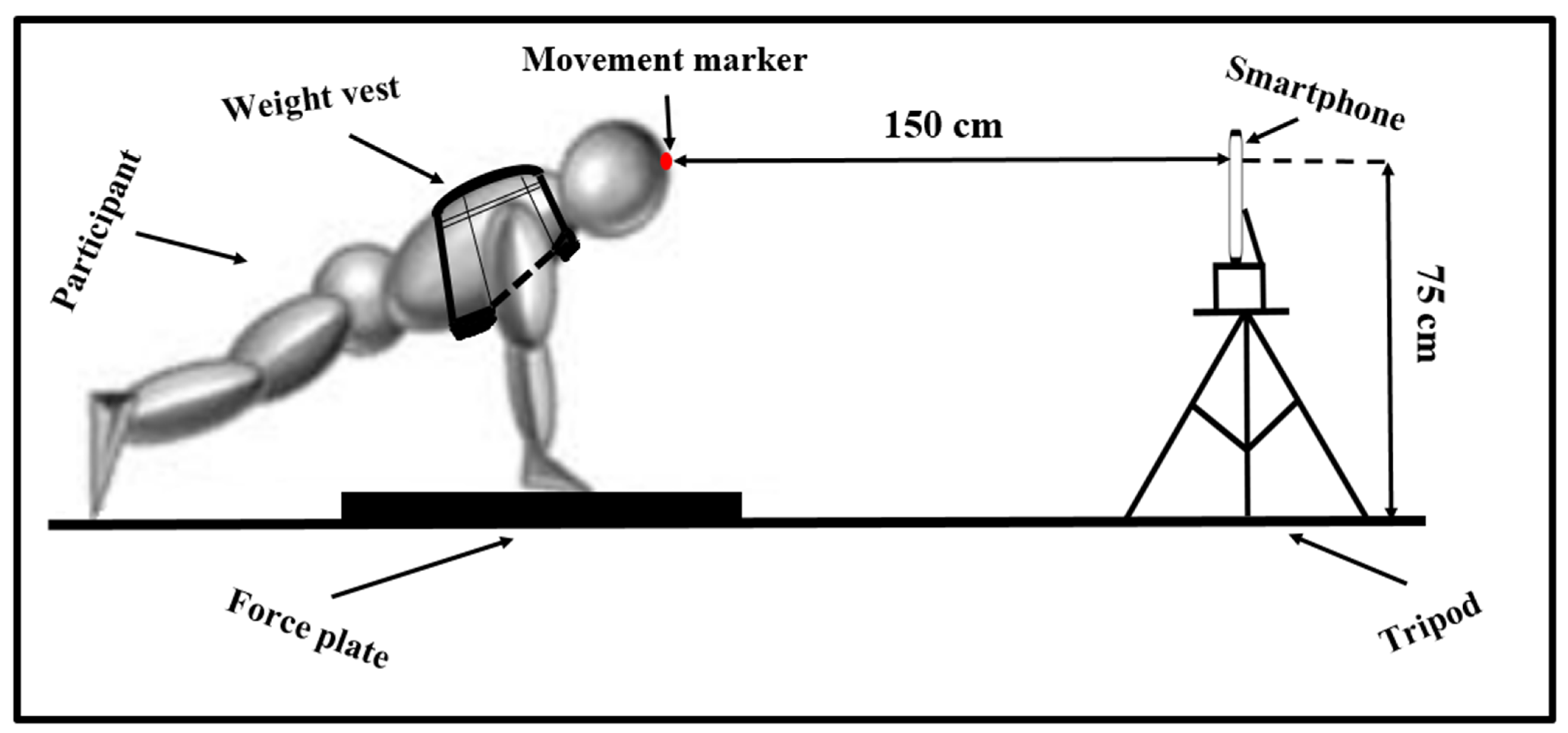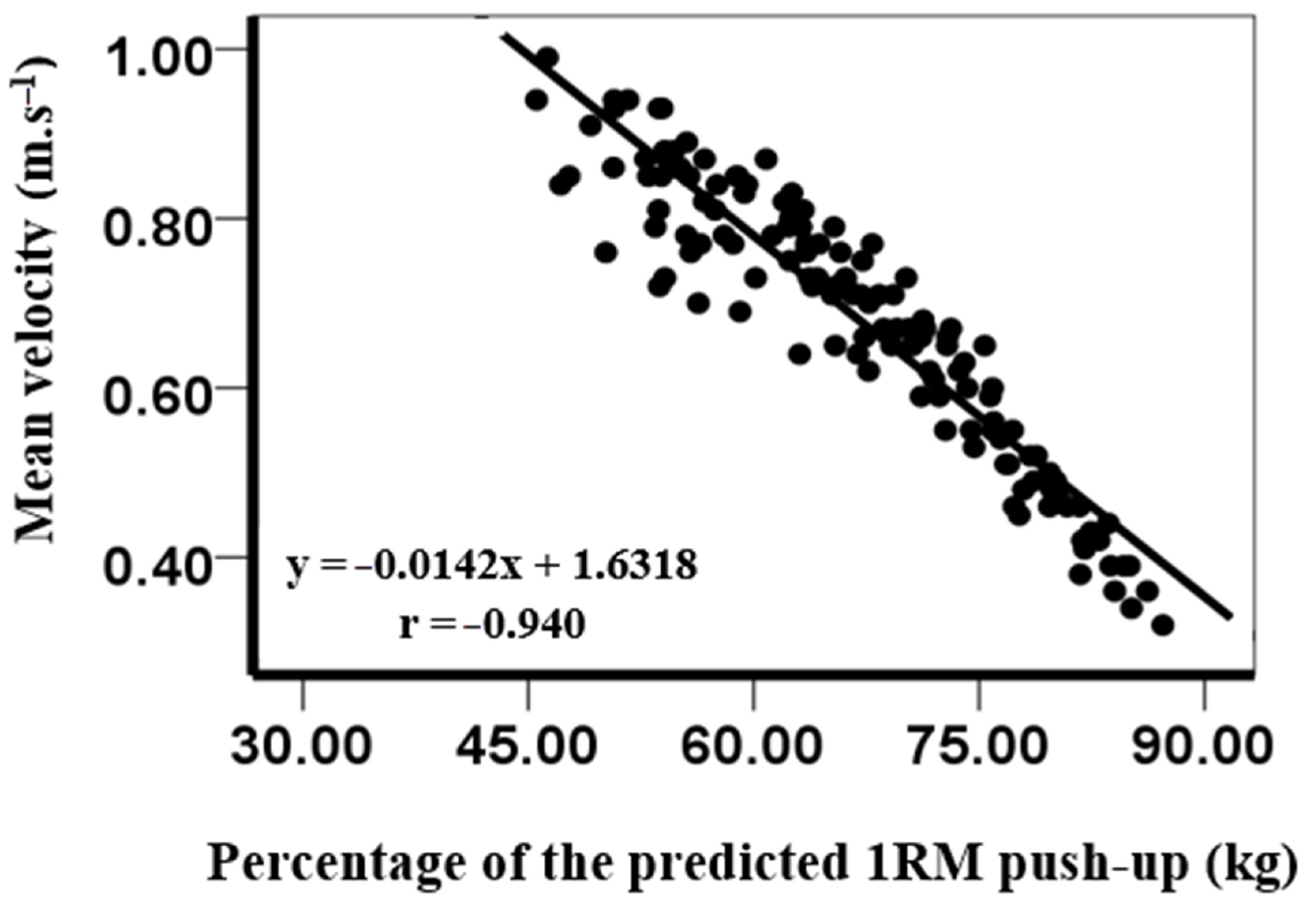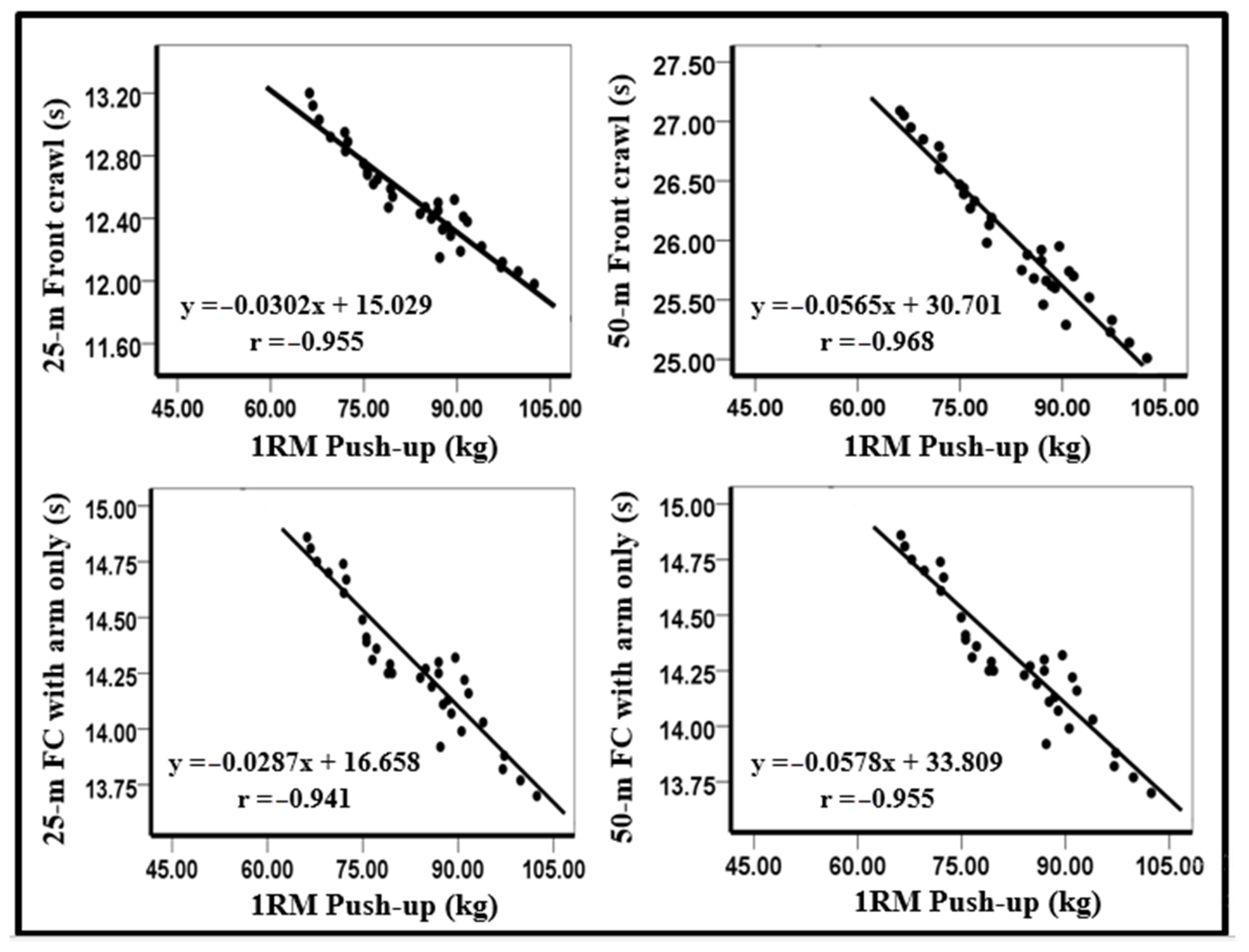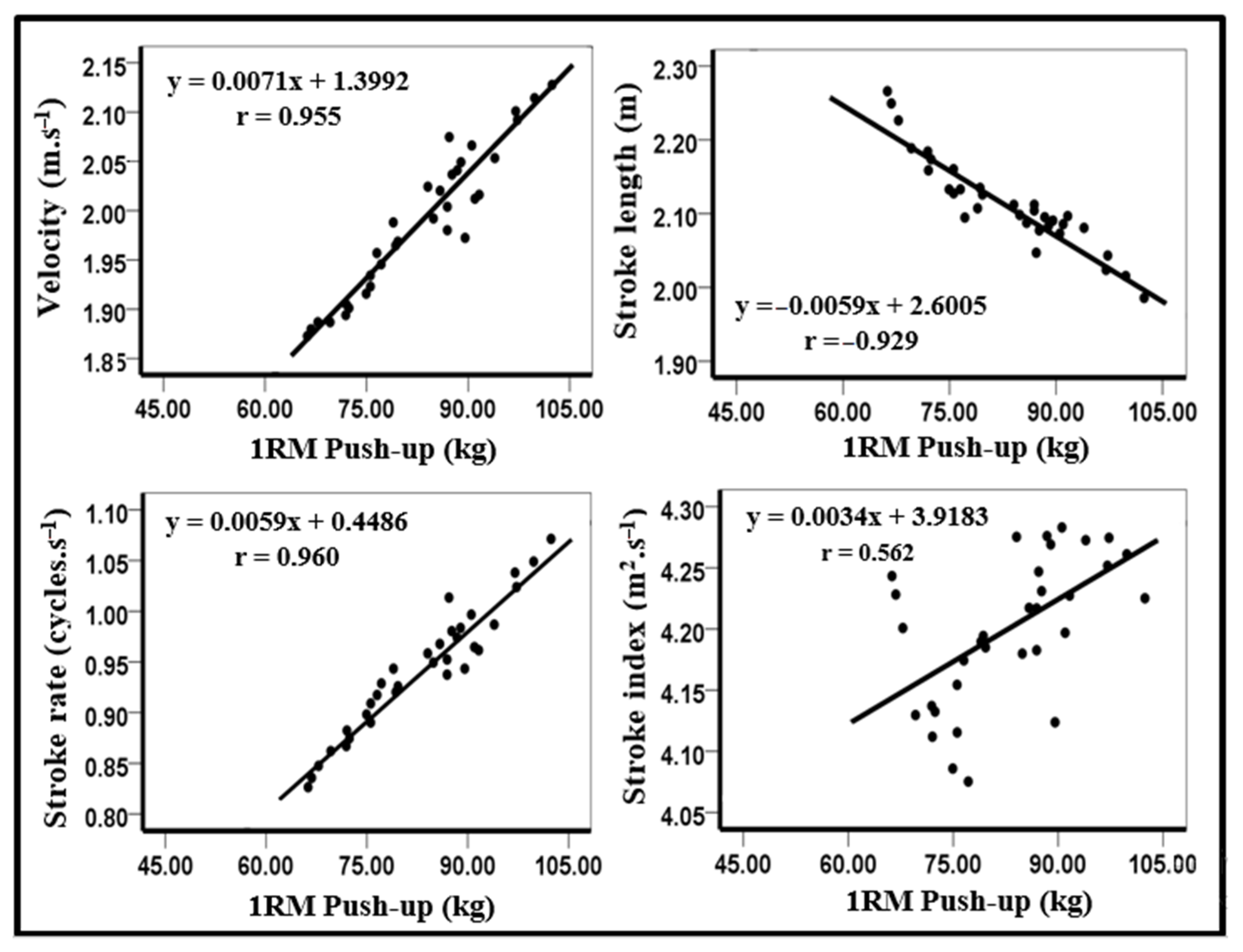Relationship between Swimming Performance, Biomechanical Variables and the Calculated Predicted 1-RM Push-up in Competitive Swimmers
Abstract
1. Introduction
2. Materials and Methods
2.1. Experimental Approach to the Problem
2.2. Participants
2.3. Procedures
2.3.1. Maximum Strength Prediction Test
2.3.2. Swimming Performances Tests
2.3.3. Biomechanical Variable Tests
2.4. Statistical Analyses
3. Results
4. Discussion
5. Conclusions
Author Contributions
Funding
Institutional Review Board Statement
Informed Consent Statement
Data Availability Statement
Acknowledgments
Conflicts of Interest
References
- Lopes, T.J.; Neiva, H.P.; Gonçalves, C.A.; Nunes, C.; Marinho, D.A. The effects of dry-land strength training on competitive sprinter swimmers. J. Exerc. Sci. Fit. 2021, 19, 32–39. [Google Scholar] [CrossRef]
- Sammoud, S.; Negra, Y.; Bouguezzi, R.; Hachana, Y.; Granacher, U.; Chaabene, H. The effects of plyometric jump training on jump and sport-specific performances in prepubertal female swimmers. J. Exerc. Sci. Fit. 2021, 19, 25–31. [Google Scholar] [CrossRef]
- Keiner, M.; Rähse, H.; Wirth, K.; Hartmann, H.; Fries, K.; Haff, G.G. Influence of Maximal Strength on In-Water and Dry-Land Performance in Young Water Polo Players. J. Strength Cond. Res. 2020, 34, 1999–2005. [Google Scholar] [CrossRef] [PubMed]
- Keiner, M.; Wirth, K.; Fuhrmann, S.; Kunz, M.; Hartmann, H.; Haff, G.G. The influence of upper- and lower-body maximum strength on swim block start, turn, and overall swim performance in sprint swimming [published online ahead of print, 2019 Aug 15]. J. Strength Cond. Res. 2019, 10.1519/JSC. [Google Scholar] [CrossRef]
- Girold, S.; Jalab, C.; Bernard, O.; Carette, P.; Kemoun, G.; Dugué, B. Dry-land strength training vs. electrical stimulation in sprint swimming performance. J. Strength Cond. Res. 2012, 26, 497–505. [Google Scholar] [CrossRef]
- Girold, S.; Maurin, D.; Dugué, B.; Chatard, J.C.; Millet, G. Effects of dry-land vs. resisted- and assisted-sprint exercises on swimming sprint performances. J. Strength Cond. Res. 2007, 21, 599–605. [Google Scholar] [CrossRef][Green Version]
- Aspenes, S.; Kjendlie, P.L.; Hoff, J.; Helgerud, J. Combined strength and endurance training in competitive swimmers. J. Sports Sci. Med. 2009, 8, 357–365. [Google Scholar] [PubMed]
- Van den Tillaar, R.; Ball, N. Push-Ups are Able to Predict the Bench Press 1-RM and Constitute an Alternative for Measuring Maximum Upper Body Strength Based on Load-Velocity Relationships. J. Hum. Kinet. 2020, 73, 7–18. [Google Scholar] [CrossRef]
- Jimenez-Olmedo, J.M.; Penichet-Tomás, A.; Villalón-Gasch, L.; Pueo, B. Validity and reliability of smartphone high-speed camera and Kinovea for velocity-based training measurement. J. Hum. Sport Exerc. 2021, 16. [Google Scholar] [CrossRef]
- Puig-Diví, A.; Escalona-Marfil, C.; Padullés-Riu, J.M.; Busquets, A.; Padullés-Chando, X.; Marcos-Ruiz, D. Validity and reliability of the Kinovea program in obtaining angles and distances using coordinates in 4 perspectives. PLoS ONE. 2019, 14, e0216448. [Google Scholar] [CrossRef]
- Velázquez, J.S.; Iznaga-Benítez, A.M.; Robau-Porrúa, A.; Sáez-Gutiérrez, F.L.; Cavas, F. New Affordable Method for Measuring Angular Variations Caused by High Heels on the Sagittal Plane of Feet Joints during Gait. Appl. Sci. 2021, 11, 5605. [Google Scholar] [CrossRef]
- Muro-De-La-Herran, A.; Garcia-Zapirain, B.; Mendez-Zorrilla, A. Gait analysis methods: An overview of wearable and non-wearable systems, highlighting clinical applications. Sensors 2014, 14, 3362–3394. [Google Scholar] [CrossRef]
- Wang, M.; Gu, Y.; Baker, J.S. Analysis of foot kinematics wearing high heels using the Oxford foot model. Technol. Health Care 2018, 26, 815–823. [Google Scholar] [CrossRef] [PubMed]
- González-Badillo, J.J.; Marques, M.C.; Sánchez-Medina, L. The importance of movement velocity as a measure to control resistance training intensity. J. Hum. Kinet 2011, 29A, 15–19. [Google Scholar] [CrossRef]
- Amara, S.; Barbosa, T.M.; Negra, Y.; Hammami, R.; Khalifa, R.; Chortane, S.G. The Effect of Concurrent Resistance Training on Upper Body Strength, Sprint Swimming Performance and Kinematics in Competitive Adolescent Swimmers. A Randomized Controlled Trial. Int. J. Environ. Res. Public Health 2021, 18, 10261. [Google Scholar] [CrossRef]
- Costill, D.L.; Kovaleski, J.; Porter, D.; Kirwan, J.; Fielding, R.; King, D. Energy expenditure during front crawl swimming: Predicting success in middle-distance events. Int. J. Sports. Med. 1985, 6, 266–270. [Google Scholar] [CrossRef] [PubMed]
- Zacca, R.; Azevedo, R.; Peterson Silveira, R.; Vilas-Boas, J.P.; Pyne, D.B.; Castro, F.A.S.; Fernandes, R.J. Comparison of Incremental Intermittent and Time Trial Testing in Age-Group Swimmers. J. Strength Cond. Res. 2019, 33, 801–810. [Google Scholar] [CrossRef]
- Hopkins, W.G.; Marshall, S.W.; Batterham, A.M.; Hanin, J. Progressive statistics for studies in sports medicine and exercise science. Med. Sci. Sports. Exerc. 2009, 41, 3–13. [Google Scholar] [CrossRef]
- Morouço, P.G.; Marinho, D.A.; Izquierdo, M.; Neiva, H.; Marques, M.C. Relative Contribution of Arms and Legs in 30 s Fully Tethered Front Crawl Swimming. Biomed. Res. Int. 2015, 2015, 563206. [Google Scholar] [CrossRef] [PubMed]
- Craig, A.B., Jr.; Skehan, P.L.; Pawelczyk, J.A.; Boomer, W.L. Velocity, stroke rate, and distance per stroke during elite swimming competition. Med. Sci. Sports. Exerc. 1985, 17, 625–634. [Google Scholar] [CrossRef]
- Strass, D. Effects of maximal strength training on sprint performance of competitive swimmers. Swim. Sci. V 1988, 16, 149–156. [Google Scholar]
- Gola, R.; Urbanik, C.; Iwańska, D.; Madej, A. Relationship between muscle strength and front crawl swimming velocity. Hum. Mov. 2014, 15, 110–115. [Google Scholar] [CrossRef]
- Martens, J.; Figueiredo, P.; Daly, D. Electromyography in the four competitive swimming strokes: A systematic review. J. Electromyogr. Kinesiol. 2015, 25, 273–291. [Google Scholar] [CrossRef] [PubMed]




| Swimmers Characteristics | National Competitive Male Swimmers (N = 33) |
|---|---|
| Age (yr-old) | 16.46 ± 0.59 |
| Height (cm) | 180.56 ± 5.69 |
| Body mass (kg) | 72.82 ± 8.41 |
| Swimming training experience (years) | 9.50 ± 0.71 |
| Resistance training experience (years) | 6.08 ± 0.37 |
| Load | 1 | 2 | 3 | 4 |
|---|---|---|---|---|
| Push-up conditions | 0 kg | +10 kg | +20 kg | +30 kg |
| Body mass plus weight vest (kg) | 72.82 ± 8.41 | 82.82 ± 8.41 | 92.82 ± 8.41 | 102.82 ± 8.41 |
| Actual load lifted (kg) | 44.69 ± 7.55 | 52.20 ± 8.12 | 59.11 ± 8.31 | 66.67 ± 8.66 |
| % of body mass (+weight vest) | 61.00 ± 3.37 | 62.69 ± 3.49 | 63.41 ± 3.18 | 64.60 ± 3.14 |
| Mean velocity (m∙s−1) | 0.85 ± 0.07 | 0.76 ± 0.07 | 0.65 ± 0.06 | 0.46 ± 0.07 |
Publisher’s Note: MDPI stays neutral with regard to jurisdictional claims in published maps and institutional affiliations. |
© 2021 by the authors. Licensee MDPI, Basel, Switzerland. This article is an open access article distributed under the terms and conditions of the Creative Commons Attribution (CC BY) license (https://creativecommons.org/licenses/by/4.0/).
Share and Cite
Amara, S.; Chortane, O.G.; Negra, Y.; Hammami, R.; Khalifa, R.; Chortane, S.G.; van den Tillaar, R. Relationship between Swimming Performance, Biomechanical Variables and the Calculated Predicted 1-RM Push-up in Competitive Swimmers. Int. J. Environ. Res. Public Health 2021, 18, 11395. https://doi.org/10.3390/ijerph182111395
Amara S, Chortane OG, Negra Y, Hammami R, Khalifa R, Chortane SG, van den Tillaar R. Relationship between Swimming Performance, Biomechanical Variables and the Calculated Predicted 1-RM Push-up in Competitive Swimmers. International Journal of Environmental Research and Public Health. 2021; 18(21):11395. https://doi.org/10.3390/ijerph182111395
Chicago/Turabian StyleAmara, Sofiene, Oussama Gaied Chortane, Yassine Negra, Raouf Hammami, Riadh Khalifa, Sabri Gaied Chortane, and Roland van den Tillaar. 2021. "Relationship between Swimming Performance, Biomechanical Variables and the Calculated Predicted 1-RM Push-up in Competitive Swimmers" International Journal of Environmental Research and Public Health 18, no. 21: 11395. https://doi.org/10.3390/ijerph182111395
APA StyleAmara, S., Chortane, O. G., Negra, Y., Hammami, R., Khalifa, R., Chortane, S. G., & van den Tillaar, R. (2021). Relationship between Swimming Performance, Biomechanical Variables and the Calculated Predicted 1-RM Push-up in Competitive Swimmers. International Journal of Environmental Research and Public Health, 18(21), 11395. https://doi.org/10.3390/ijerph182111395








